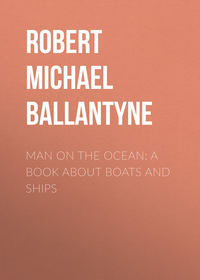
Man on the Ocean: A Book about Boats and Ships

R. M. Ballantyne
Man on the Ocean: A Book about Boats and Ships
Chapter One.
Treats of Ships in General
There is, perhaps, no contrivance in the wide world more wonderful than a ship—a full-rigged, well-manned, gigantic ship!
Those who regard familiar objects in art and nature as mere matters of course, and do not trouble themselves to wander out of the beaten track of everyday thought, may not at first feel the force or admit the truth of this statement. Let such folk endeavour to shake themselves vigorously out of this beaten track of everyday thought. Let them knit their brows and clench their teeth, and gaze steadfastly into the fire, or up at the sky, and try to realise what is involved in the idea of—a ship.
What would the men of old have said, if you had told them that you intended to take yonder large wooden house, launch it upon the sea, and proceed in it out of sight of land for a few days? “Poor fellow,” they would have replied, “you are mad!” Ah! many a wise philosopher has been deemed mad, not only by men of old, but by men of modern days. This “mad” idea has long since been fulfilled; for what is a ship but a wooden house made to float upon the sea, and sail with its inmates hither and thither, at the will of the guiding spirit, over a trackless unstable ocean for months together? It is a self-sustaining movable hotel upon the sea. It is an oasis in the desert of waters, so skilfully contrived as to be capable of advancing against wind and tide, and of outliving the wildest storms—the bitterest fury of winds and waves. It is the residence of a community, whose country for the time being is the ocean; or, as in the case of the Great Eastern steamship, it is a town with some thousands of inhabitants launched upon the deep.
Ships are, as it were, the electric sparks of the world, by means of which the superabundance of different countries is carried forth to fill, reciprocally, the voids in each. They are not only the media of intercourse between the various families of the human race, whereby our shores are enriched with the produce of other lands, but they are the bearers of inestimable treasures of knowledge from clime to clime, and of gospel light to the uttermost ends of the earth.
But for ships, we should never have heard of the wonders of the coral isles and the beauties of the golden South, or the phenomena and tempests of the icy North. But for ships, the stirring adventures and perils of Magellan, Drake, Cook, etcetera, had never been encountered; and even the far-famed Robinson Crusoe himself had never gladdened, and saddened, and romantically maddened the heart of youth with his escapes, his fights, his parrots, and his philosophy, as he now does, and as he will continue to do till the end of time.
Some account, then, of ships and boats, with anecdotes illustrative of the perils to which they are frequently exposed, cannot fail, we think, to prove interesting to all, especially to boys, for whose particular edification we now write. Boys, of all creatures in this world, are passionately fond of boats and ships; they make them of every shape and size, with every sort of tool, and hack and cut their fingers in the operation, as we know from early personal experience. They sail them, and wet their garments in so doing, to the well-known sorrow of all right-minded mammas. They lose them, too, and break their hearts, almost, at the calamity. They make little ones when they are little, and big ones when they grow big; and when they grow bigger they not unfrequently forsake the toy for the reality, embark in some noble craft, and wed the stormy sea.
A word in your ear, reader, at this point. Do not think that because you fall in love with a ship you will naturally and necessarily fall in love with the sea! Some do, and some don’t: with those who do, it is well; with those who don’t, and yet go to sea, it is remarkably ill. Think philosophically about “going to sea,” my lads. Try honestly to resist your own inclination as long as possible, and only go if you find that you can’t help it! In such a case you will probably find that you are cut out for it—not otherwise. We love the sea with a true and deep affection, and often have we tossed upon her foam-topped waves; but we don’t wish to be a sailor—by no manner of means!
And now, boys, come along, and we will conduct you as pleasantly and profitably as we can from a ship’s cradle, through all her stormy existence, to her grave.
Chapter Two.
The Earliest Days of Water-Travelling
Once upon a time there were no ships. Men did not know the meaning of the word; they did not want them; and, for many, many centuries the sea-gulls had the ocean all to themselves. But boats are of very ancient date. Doubtless the first boats must have been constructed by the first men who dwelt on the earth. They consisted, probably—for we are now in the land of conjecture—of stumps of fallen trees, or bundles of rushes, seated astride of which the immediate descendants of our first parents ferried themselves over small lakes and across rivers.
Wet feet are not agreeable under any circumstances. We can conceive that prolonged voyages performed in this fashion—say several hundred yards or a mile—rendered those primitive mariners so uncomfortable, that they resolved to improve their condition; and, after much earnest thought, hit upon the plan of fastening several logs together by means of twigs, and thus they formed rafts.
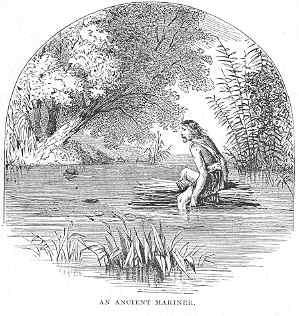
As time progressed, and men began to display wisdom in making tools of stone and in the moulding of metal, we can imagine that they soon bethought themselves of flattening the surface of their rafts; and then, finding them unwieldy and difficult to manage, no doubt, they hit upon the idea of hollowing out the logs. Adzes were probably not invented at that time, so they betook themselves to the element of fire—which is at the present day used by savage nations for the same purpose—and burned out the insides of their logs. Thus canoes sprang into being.
But such canoes were clumsy and heavy, besides being liable to split; men therefore bethought themselves of constructing a light framework of wood, which they covered with bark or skin. Then artificers in iron invented saws; logs were ripped up; planks were formed; pitch oozed ready to hand from the trees; with grass, perchance, they caulked the seams;—and soon the first boat floated on the water—clumsy and tub-like, no doubt, but serviceable withal—and youths of a hundred years old, and full-grown men of two or three hundred, capered and shouted on the shore with delight at the great invention; while venerable patriarchs, of seven or eight hundred summers, gazed in wonder, with almost prophetic solemnity, and exclaimed that they had never before seen the like of that in all the course of their long, long lives!
Those times are old now—so old that men can scarcely get their minds to realise how old they are; nevertheless, the craft that were used then are used even now, and that not only among the savages of distant lands, but by men living at our very doors.
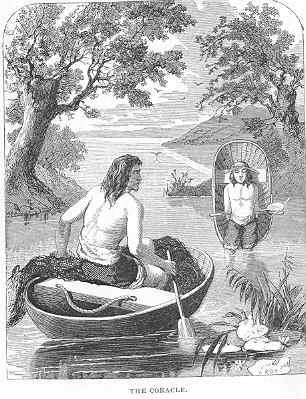
The coracle, a basket-boat of the most primitive description, is still occasionally met with in South Wales. It is neither more nor less than a large wicker basket covered with a hide, and is tub-shaped, and clumsy to a degree. When the Romans invaded Britain, this species of boat was in common use. Like the canoe of the North American Indian, it is easily upset, and we should think must be rather unmanageable; but as we are not likely ever again to be reduced to it in this country, we can afford to regard its faults with indifference.
From little boats to big boats there is but a step; and no doubt rivers were soon navigated, and new countries explored, while those who lived near the sea-coast dared even to launch their boats upon the ocean; but they “hugged the shore,” undoubtedly, and seldom ventured to proceed at night unless the stars shone brightly in the sky.
Years rolled on, and dwellers on the sea-coast became more and more venturous in their voyages along the shore. It behoved them to have larger boats, or barges, with numerous rowers, who would naturally carry weapons with them to guard themselves from foes. War-galleys sprang into being. Strong winds sometimes carried these off-shore, and out of sight of land. Ah, reader! who can conceive the feelings of the first mariners who saw the solid land sink on the horizon, and beheld nothing substantial in all the waste of waters, save their own tiny bark that reeled beneath them on the heaving billows? Perchance these first adventurers on the deep found their way back to land, and afterwards tried the bold experiment of steering by the stars. Perhaps not; but at length it did come about that ships were built, and men were found bold enough to put to sea in them for days and weeks together.
The ark is the first ship of which we have any authentic account. We now leave the region of conjecture; for the ark was built by Noah under the immediate direction of the Almighty, and we have a minute account of it in the Bible.
More than two thousand three hundred years before our Lord and Saviour Jesus Christ came to earth, man’s wickedness had attained to such a height that God resolved to destroy the inhabitants of the world by a deluge. But, in the midst of wrath, God remembered mercy. He spared Noah and his family, and saved them from destruction by placing them in the ark along with pairs of the lower animals.
Every reader of the Bible knows the story of the deluge; but everyone may not be aware that traditions of this deluge are found in every part of the earth. East, west, north, and south—civilised and savage—all men tell us of a great flood which once covered the world, and from which only one family was saved, in a boat, or a canoe, or an ark.
What the barbarous and savage nations know dimly from tradition, we know certainly and fully from the inspired Word of God. The ark was built; the flood came; Noah with his family and two of every living creature entered into it; and for months the first ship floated on a sea whose shoreless waves flowed round and round the world.
What the ark’s form was we cannot precisely tell; but we know its dimensions pretty accurately.
Although it was not intended for voyaging, the ark must necessarily have been a perfect model of a vessel, meant to float upon the waters. To some extent, too, it must have been fitted to ride upon turbulent billows; for it “went upon the face of the waters” for upwards of seven months, and before it rested finally on the top of Mount Ararat, “God made a wind to pass over the earth, and the waters assuaged.” In regard to its size, the most interesting way to consider it, perhaps, will be to compare it with the Great Eastern, the largest ship that has yet been built by man. Assuming a cubit to be about 18 inches, the length of the ark was about 450 feet, its breadth about 75 feet, and its depth about 45 feet.
The Great Eastern’s length is 680 feet, its breadth 83 feet, and its depth from deck to keel 60 feet.
The ark was built of gopher-wood, which is thought by some to be pine, by others cedar. It consisted of three stories, and had a window and a door, and was pitched within and without. But it had neither masts nor rudder; and it is evident that, although it was man’s refuge, the ark was not designed to be managed by man, for after Noah and his family had entered in, God took on himself the guidance and preservation of their vessel. Thus our Saviour—of whom the ark was a type—specially guides and protects those who flee to him for refuge.
But although we have noticed the ark as being the first ship, we cannot with propriety place it in the front of the history of navigation. After the flood the ark seems to have been soon forgotten, or at least imperfectly remembered, and men reverted to their little canoes and clumsy boats, which sufficed for all their limited wants. It was not until about a thousand years later in the world’s history that men built ships of considerable size, and ventured on prolonged coasting-voyages, for the purposes of discovery and commerce. Navigation had been practised, and the art of ship-building had made very considerable progress, long before men dared to lose sight of the shore and venture out upon the mysterious bosom of the great unknown sea.
To the ancients the Mediterranean was the ocean; and among its bays, and creeks, and islands, maritime enterprise sprang into being and rose into celebrity. Among the Phoenicians, the Egyptians, and Hebrews, we find the earliest traces of navigation and commerce. The first of these nations, occupying the narrow slip of land between Mount Lebanon and the Mediterranean, rose into fame as mariners between the years 1700 and 1100 before Christ—the renowned city of Sidon being their great sea-port, whence their ships put forth to trade with Cyprus and Rhodes, Greece, Sardinia, Sicily, Gaul, and Spain. Little is known of the state of trade in those days, or of the form or size of ancient vessels. Homer tells us, in his account of the Trojan War, that the Phoenicians supplied the combatants with many articles of luxury; and from Scripture we learn that the same enterprising navigators brought gold to Solomon from Ophir in the year 1000 B.C.

A short time previous to this the Phoenicians ventured to pass through the Strait of Gibraltar, and for the first time beheld the great Atlantic Ocean. Proceeding along the coast of Spain, they founded Cadiz; and, not long after, creeping down the western coast of Africa, established colonies there. But their grandest feat was achieved about 600 years B.C., when they sailed down the Red Sea and the eastern coast of Africa, doubled the Cape of Good Hope, sailed up the western coast, and returned home by the Strait of Gibraltar. Bartholomew Diaz must hide his diminished head before this fact; for, although he gets all the credit, the Phoenicians of old “doubled the Cape” at least twenty centuries before him!
That long voyages were made by the men of old, before authentic history began, seems highly probable. The expedition of the Argonauts to Colchis in the year 1250 B.C., in search of the “Golden Fleece,” is the first ancient voyage that lays claim to authenticity. What the Golden Fleece was is uncertain; some think it was a term used to symbolise the mines of precious metals near the Black Sea. Whatever it was, the Argonauts went in search of it: whether or not they found it is unrecorded in history. Jason, son of the King of Thessaly, was the leader of this expedition, which consisted of one ship and fifty men. A man named Argus built the ship, which from him was named the Argo, hence the name of Argonauts.
In treating of ancient vessels, we may as well proceed on the principle suggested by a sagacious child, who, when his mother was about to tell him a story, usually begged of her to “bedin at the bedinning.” We shall begin at the beginning.
Chapter Three.
Rafts and Canoes
Rafts, as we have already remarked, must undoubtedly have been the beginning of navigation. But they have not, like many other species of ancient craft, been altogether superseded by modern inventions. True, we do not nowadays carry on war on rafts, but we still carry on trade with them in many parts of the world. How the rafts of ancient times were formed we cannot tell precisely, though we can easily guess; but one thing we know, and that is, that the first improvement made in such craft was the thrusting of a few thick planks down into the water, to the depth of three or four feet, between the logs which composed the raft. These acted the part of a keel, and, by pressing against the water side-ways when a side wind blew, prevented the raft from making much of what is called leeway—that is, drifting in the direction in which the wind happened to be blowing. Some sorts of Dutch vessels use lee-boards for this purpose at the present time.
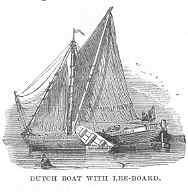
The rafts now in use on the great rivers of America are exceedingly curious in many respects. One peculiarity of many of them is that they float themselves, not goods, to market—the pine logs of which they are constructed being the marketable commodity. Some of these “lumber-rafts,” as they are called, are of great size; and as their navigators have often to spend many weeks on them, slowly floating down the rivers, they build huts or little cottages on them, cook their provisions on board, and, in short, spend night and day in their temporary floating-homes as comfortably as if they were on the land.
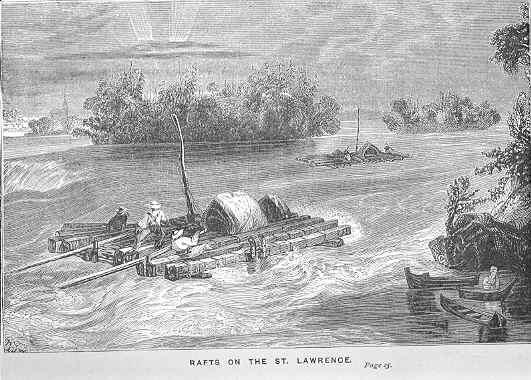
When these rafts approach a waterfall or a rapid, they unfasten the lashings and allow several logs tied together to run down at a time. After the rapid is passed, the loose logs are collected together, the raft is reconstructed, and the voyage down to the sea continued. Of course, huts are built only on rafts which navigate the largest rivers, and are not thus liable to be taken to pieces.
When the logs reach the sea, they are shipped to various parts of the world where timber is scarce. Large quantities are imported into Great Britain from Canada and other parts of America.
A bold thing has occasionally been done. Instead of shipping the logs in vessels, enterprising and ingenious men built them into a solid ship, leaving a small space to serve as a cabin and a hold for provisions; then, erecting masts, they hoisted sail, and in this singular craft crossed the Atlantic. On arriving at port they broke up their raft-ship and sold it.
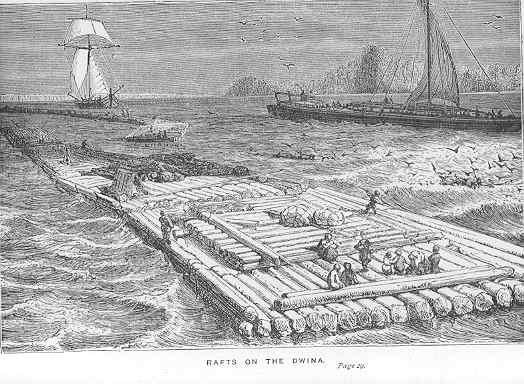
The immense size of the rafts which are floated down some of the great rivers of the world may be gathered from the following engraving, which represents a raft on the Dwina, one of the great rivers of Russia.
Rafts, however, have not been confined to the purposes of traffic. They have frequently been the means of saving the lives of shipwrecked mariners; but too often they have been the means only of prolonging the wretched existence of those who have ultimately perished at sea.
Turning now from the consideration of rafts, we shall describe canoes.
Canoes must, we think, have been invented after rafts. They were formed, as we have said, out of logs, of bark and of skins stretched upon frames of wood. Of ancient canoes we can say little. But it is probable that they were similar in most respects to the canoes used by savage nations at the present time; for man, in his lowest or most savage condition, is necessarily the same now that he was in ancient times. We shall, therefore, take a glance at the canoes of savage nations now existing, and thus shall form a good idea, we doubt not, of what canoes were in days of old.
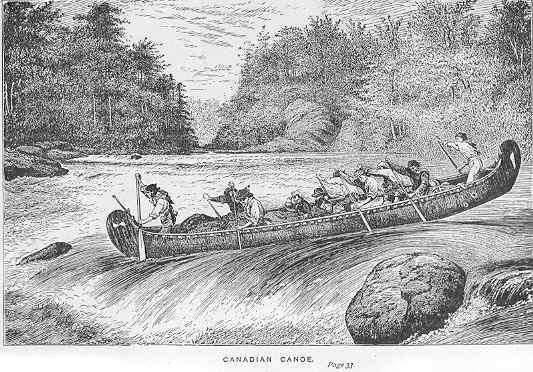
Simplest among them all, perhaps, are the canoes of the North American Indians. These are built of thin laths and ribs of wood, and are covered with the bark of the birch-tree. The sheets of bark are not a quarter of an inch thick. Several sheets are used in the covering of one canoe. They are sewed together with the long pliant roots of the pine, and the seams are rendered tight with gum procured from the same tree. So light are these canoes, that two men can carry on their shoulders one capable of holding eight or ten men, with their provisions, etcetera, for a voyage of many months. They are of various sizes—from the hunting canoe which holds one Indian, to the largest canoe that carries fourteen. They are propelled by short paddles instead of oars.
Many and terrible are the risks run by voyageurs who travel through the lakes and rivers of North America in these canoes.
The following anecdote is related of a narrow escape made by some fur-traders while descending one of the rivers in the backwoods of the Hudson Bay Territory:– One fine evening in autumn, a north-canoe was gliding swiftly down one of the noble bends in the river referred to. New, beautiful, and ever-changing scenes were being constantly opened up to the view of the voyageurs, whose plaintive and beautiful canoe-songs were rolling over the waters. Suddenly the song ceased as the distant roar of a waterfall struck their ears, and the steersmen—for there are usually two, one in the bow and one in the stern—prepared to land and “make a portage,”—that is, carry the canoe and lading past the falls by land, and re-launch and re-load in the smooth water below.
The approach to the landing-place at the head of the fall was somewhat difficult, owing to a point of rock which projected into the stream in the direction of the fall, and round which point it was necessary to steer with some dexterity, in order to avoid being drawn into the strong current. The fearless guides, however, had often passed the place in former years in safety, and accordingly dashed at the point with reckless indifference, their paddles flinging a circle of spray over their heads as they changed from side to side with graceful but vigorous rapidity. The swift stream carried them quickly round the point of danger, and they had almost reached the quiet eddy near the landing-place when the stem of the canoe was caught by the current, which instantly whirled it out from the shore and carried it down stream like an arrow. Another moment, and the gushing water dragged them to the verge of the fall, which thundered and foamed among frightful chasms and rocks many feet below. It was the work of a moment. The stern of the canoe almost overhung the abyss, and the voyageurs plied their paddles with the desperation of men who felt that their lives depended on the exertions of the next awful minute. For a few seconds the canoe remained stationary, and seemed to tremble on the brink of destruction—the strength of the water and the power of the men being almost equally balanced—then, inch by inch, it began slowly to ascend the stream. The danger was past! A few nervous strokes, and the canoe shot out of the current like an arrow, and floated in safety in the still water below the point.
The whole thing, from beginning to end, occurred in a few seconds; but who can describe or comprehend the tumultuous gush of feeling aroused during those brief moments in the bosoms of the voyageurs? The sudden, electric change from tranquil safety to the verge of what appeared certain destruction—and then, deliverance! It was one of those thrilling incidents which frequently occur to those who thread the wildernesses of this world, and is little thought of by them beyond the moment of danger; yet it was one of those solemn seasons, more or less numerous in the history of all men, when the Almighty speaks to his careless creatures in a voice that cannot be mistaken, however much it may be slighted; awakening them, with a rough grasp, to behold the slender cord that suspends them over the abyss of eternity.
The canoes used by the Eskimos who inhabit the Polar Regions are made of a light framework of wood, which is covered entirely over with seal-skin—a round hole being left in the centre, in which the Eskimo sits. Round this hole there is a loose piece of skin, which is drawn up by the man and fastened round his waist. The machine is thus completely water-tight. No waves can dash into, although they can sweep over it; and if by chance it should upset, the Eskimo can turn it and himself up into the proper position by one dexterous sweep of his long, double-bladed paddle. The paddle, which varies from ten to fifteen feet, is simply a pole with a blade at each end. It is grasped in the centre, and each end dipped alternately on either side of the kayak, as this canoe is called. Eskimo kayaks are first-rate sea-boats. They can face almost any sort of weather. They are extremely light, and are propelled by the natives very swiftly. In these frail canoes the natives of the Polar Regions pursue seals and whales, and even venture to attack the walrus in his native element. The kayak is used exclusively by the men. The oomiak, or women’s canoe, is of much larger and clumsier construction, somewhat like a boat. It is open above, and can hold a large family of women and children. Like the kayak, it is a framework of wood covered with seal-skin, and is propelled by means of short paddles of the spoon form.